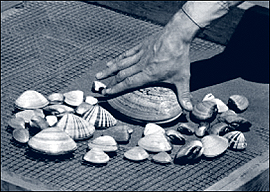Coastal Morphology Group • Scripps Institution of Oceanography
Santa Maria Cell
 n unusual crescent beach cell, the Santa Maria littoral cell is an excellent example of the action of headlands in containing littoral transport. Its north/south trending coast is exposed to the open ocean without any island sheltering. The shelf is wide and gently sloped with no submarine canyon sink. The headland of Point Sal acts as a groin and has trapped abundant sediment principally from the Santa Maria River. Widespread dune fields are evidence of the plentiful sand supply to this cell.
n unusual crescent beach cell, the Santa Maria littoral cell is an excellent example of the action of headlands in containing littoral transport. Its north/south trending coast is exposed to the open ocean without any island sheltering. The shelf is wide and gently sloped with no submarine canyon sink. The headland of Point Sal acts as a groin and has trapped abundant sediment principally from the Santa Maria River. Widespread dune fields are evidence of the plentiful sand supply to this cell.
As rising sea level moved the coastline into the wave shadow of Point Buchon 12-11,000 years ago, beaches backed by dunes probably were building on the wide, gently sloping shelf. Intermittent but strong El Niños in the period 12-8,000 years ago brought huge amounts of sand to the coast, and the El Niño wave direction transported sand to the northern beaches in the shelter of Point Buchon. Under the predominantly La Niña wave climate 8-5,000 years ago, the massive headland of Buchon sheltered the beaches from northwest waves.
Estuaries developed behind the dunes as rising sea level flooded stream valleys. One of the largest estuarine systems in southern California formed near the mouth of the Arroyo Grande. Nearby, the oldest archaeological sites in the Santa Maria cell, dated to more than 9,000 years ago, contain lots of estuarine shell and the earliest radiocarbon dates on Pismo clam for the entire coast of southern California. The Pismo clam is a large slow-growing bivalve that lives only on wave-swept, perennial sand beaches.

Image courtesy California Department Fish and Game.
The other littoral cells of southern California lack such massive headlands. Their sand beaches accreted later and eroded more often during the Holocene.
Coastal Morphology Group • Scripps Institution of Oceanography
©2002-2004 by the Regents of the University of California and the Kavli Institute.
All rights reserved.
Last modifed Tuesday August 30, 2005

